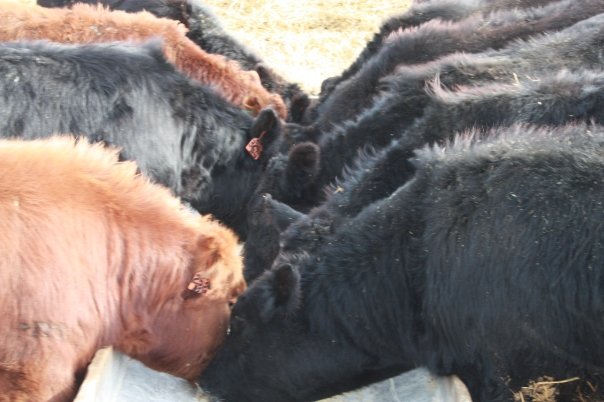Should consumers worry about cattle consuming genetically modified feeds?
Misinformation and confusion about genetically modified foods and what that really entails may result in consumers putting the brakes on buying certain products. Are concerns about GM feeds for livestock going to cause shoppers to hesitate when buying beef?
May 16, 2018

Following the Xanto Blizzard in mid-April, where we received 24 inches of snow in two days on top of rain and hail, it’s been a slow spring around here. Not too many planters are in the field yet, and we’re hoping for some warm, windy days to allow crop farmers to work the soil and get seeds in the ground soon.
I know it won’t be long before our quiet gravel road becomes Grand Central Station with equipment rolling by on its way to the fields. As a side note, I’ve already seen two articles about near-fatal accidents involving cars and tractors on the road n Facebook this morning, which serves as a good reminder to all of us to slow down, be alert and watch for farmers on the road this spring.
READ: Tractor driver in critical condition after being struck by box truck
READ: Farmer’s warning after close call on road with tractor
In my neck of the woods, corn and soybeans are the two most common crops on rotation, and of course, most of what is planted is genetically-modified (GM) seed. In recent years, crop farmers have had to actively defend the use of GM seeds in crop production; however, it’s not as often that ranchers are tasked with debunking misconceptions about GM feed in livestock production.
Yet, we have to ask ourselves, if a consumer browsing the meat case at our local grocery store had questions about the GM feeds we offer our cattle, would we be prepared to answer them?
READ: Are beef producers ready to defend GMOs?
Today’s consumer is giving a more critical appraisal to the meats they select. Not only are they looking to meet specific health and nutritional parameters, but they also want their choices to reflect ethical and environmental ideologies that match their values and personal beliefs. Evaluating not only how livestock live, but what they eat, is just another aspect of beef production that is under scrutiny, and of course, GM feeds make a good punching bag.
We’ve seen the public outcry, the attacks on Monsanto, the fear-mongering claims, the hysterical mommy bloggers talking about genetically engineered foods. As livestock producers, we need to think critically about how we can be a part of the conversation to help shed light on the facts while alleviating the concerns about this modern advancement in food production.
A great place to start is this video from The Cornell Alliance for Science. Featuring Alison Van Eenennaam, University of California-Davis Extension animal biotechnology and genomics specialist, the video explains how 95% of all U.S. livestock eat GM feed, and that this feed is safe for the animals and doesn’t reflect on the end product that consumers eat.
VIEW: Watch the video here.
Here is what Eenennaam has to say on the subject:
“The American Association of Animal Science asked me to write a review paper on the health of livestock populations that have consumed genetically engineered feeds. We reviewed the controlled peer reviewed studies done in this area, and the vast majority of these studies have shown no detrimental effects associated with the consumptions of genetically modified feed.”
She says this conclusion was expected because first, when you digest meat, you’re digesting the DNA in the protein, and second, the ingredients these animals consumed are not toxic.
READ: Survey shows consumers want DNA labels on food
Therefore, Eenennaam’s review of the topic helped her come to the conclusion that, without question, the animal’s composition is equivalent to those of animals that didn’t consume GM crops. What’s more, the productivity and health of the animals hasn’t been impacted by animals eating GM feedstuffs.
How can she definitively come up with this conclusion? Well, for starters her data set includes billions of animals.
She says, “It’s estimated that more than 95% of the livestock populations in the U.S. are eating genetically engineered feed and have been doing so since the introduction of these crops back in 1996. Since that time, over 100 billion animals in the U.S. have been consuming these products — corn, soy, alfalfa, cottonseed meal — all coming from genetically engineered varieties. These livestock populations have been consuming these products almost continuously for the last decade.”
Even with the large data set, there wasn’t a control group not eating GM feeds to compare to during this time frame. In reviewing the studies, she considered that, and explained, “What we were able to do was look at trends prior to using genetically engineered feed, and then we looked at the years after the introduction, particularly the last decade.”
READ: 10 ways ag is using technology & GMOs to safely feed the planet
In the video, she goes on to explain some of the negative rhetoric on this topic that seems to make regular headline news.
She says, “There have been a handful of very sensational studies that have shown very contradictory results. We’ve seen studies showing big tumors and pigs showing inflamed stomachs. What’s really interesting is these studies have been unilaterally condemned by both regulators and independent scientists for not adhering to very basic scientific principles when setting up their experimental designs. For example, in one study, researchers used a variety of rats that’s been well documented to develop tumors by two years of age.
“It’s very frustrating that these groups don’t adhere to these protocols because they are set up to have replicates and the appropriate sample size to ensure that statistically important findings are actually due to the treatment rather than just chance. When you ignore these protocols, then you have these findings that appear to be very sensational and are suggested to be caused by the treatment when in fact it’s the experimental design that’s very poor and they aren’t following standard protocols.
“That’s where scientists get very frustrated when these poorly designed studies get amplified in the media because they really aren’t agreeing at all with the hundreds of studies that have shown no difference and there is no mention made of these other studies in these sensational papers.”
If approached on this topic, producers can say with confidence the GM feeds they offer their livestock allow animals to grow and thrive and ultimately have no impact on the overall quality or safety of the end product offered in the meat case.
Please, share this blog post to help spread the word. I would love for this video to be seen far and wide to give consumers more context on some of these studies and their wild assumptions about GMOs.
The opinions of Amanda Radke are not necessarily those of beefmagazine.com or Farm Progress.
About the Author(s)
You May Also Like




.png?width=300&auto=webp&quality=80&disable=upscale)
